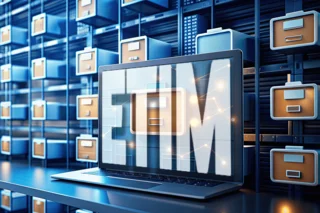Providing product data - but efficiently and consistently, please
The demands on manufacturers are increasing: More and more channels, platforms and retail partners are demanding structured, up-to-date and complete product data - often in their own formats, with different features, languages or classifications. What was still manually manageable with just a few articles and clearly defined recipients quickly becomes a challenge with increasing product range breadth and internationalization. The effort required for data maintenance and distribution increases - as does the risk of inconsistencies. The introduction of a classification standard such as ETIM creates the basis for consistent processes and long-term stable product communication.
What is ETIM - and for whom is it relevant?
The ElectroTechnical Information Model (ETIM) is an open, internationally established classification standard for technical products. The aim is to describe products clearly, system-independently and language-neutrally - regardless of sales channel or target market.
Originally anchored in electrical engineering, ETIM is now used in numerous other sectors, such as tools and factory equipment, sanitary, heating and air conditioning technology (SHAC) and the building materials trade.
For manufacturers, this means that product data no longer has to be prepared individually for each recipient, but can be structured centrally and used multiple times - across countries, channels and systems. Companies that implement product classification according to ETIM thus create a basis for efficient processes in technical trade.
Five good reasons to start using ETIM
- Standardized product data: A standardized format for all partners - without retailer-specific adaptations
- Better findability: products can be searched for and filtered in stores, portals and systems
- International use: Language neutrality thanks to ID-based modeling
- Free to use: ETIM is an open standard, accessible to companies of all sizes
- Co-design: As a member of the ETIM association, manufacturers can actively contribute to further development
How ETIM works in practice
The structure of ETIM is logical and consistent:
- Each product is assigned to a product class
- Characteristics are defined within this class
- The characteristics are assigned standardized values
A light source, for example, belongs to class "EC000037" - with characteristics such as "base type", "light color" or "wattage". This system applies across the board - regardless of product type or sector. This means that products can be clearly classified - making them much easier to compare, filter and find on the recipient side.
In practice, assigning your own product range to the appropriate ETIM classes - known as ETIM mapping - usually requires a combination of technical know-how, product understanding and system expertise.
Frequent hurdles in the introduction of ETIM
The advantages are convincing - but implementation often shows that theory is one thing, practice is another. Typical questions that manufacturers face in ETIM projects:
- How well is our product data structured - and where are there gaps?
- Which articles can be clearly assigned to an ETIM class?
- Which characteristics and values are missing from the database?
- Who is responsible for the topic internally - and how are interfaces defined?
- How can existing systems and processes be meaningfully integrated?
A sensible start can be made by analyzing the product range and its ETIM compatibility - to gain clarity about effort, data gaps and next steps.
Find out more about our ETIM workshop
For whom in the company is the topic relevant?
The implementation of ETIM usually affects several specialist areas - and benefits from an interdisciplinary approach:
- Product management, which knows the technical content
- Data and process management, which analyzes structures
- Content teams that prepare data for channels
- IT, which is responsible for systems and interfaces
Conclusion: Structure is not an end in itself - but a strategic lever
Getting started with ETIM classification is not an end in itself, but a strategic step towards better data quality, more efficient processes and a stronger position in digital sales. Manufacturers who rely on standardized structures at an early stage not only benefit from simplified processes in cooperation with retail partners, but also from better visibility of their products in digital channels.
